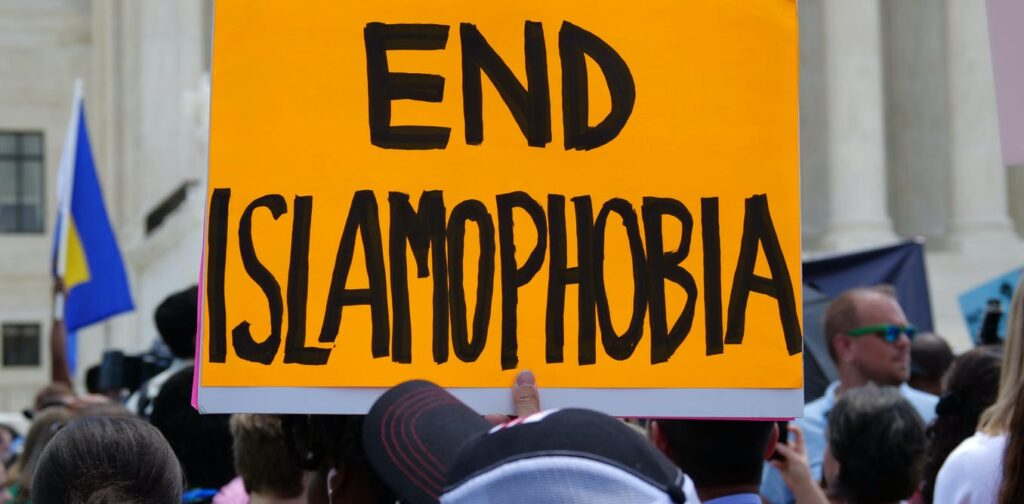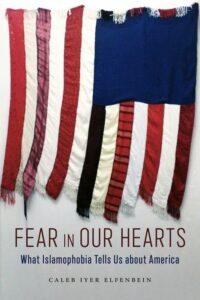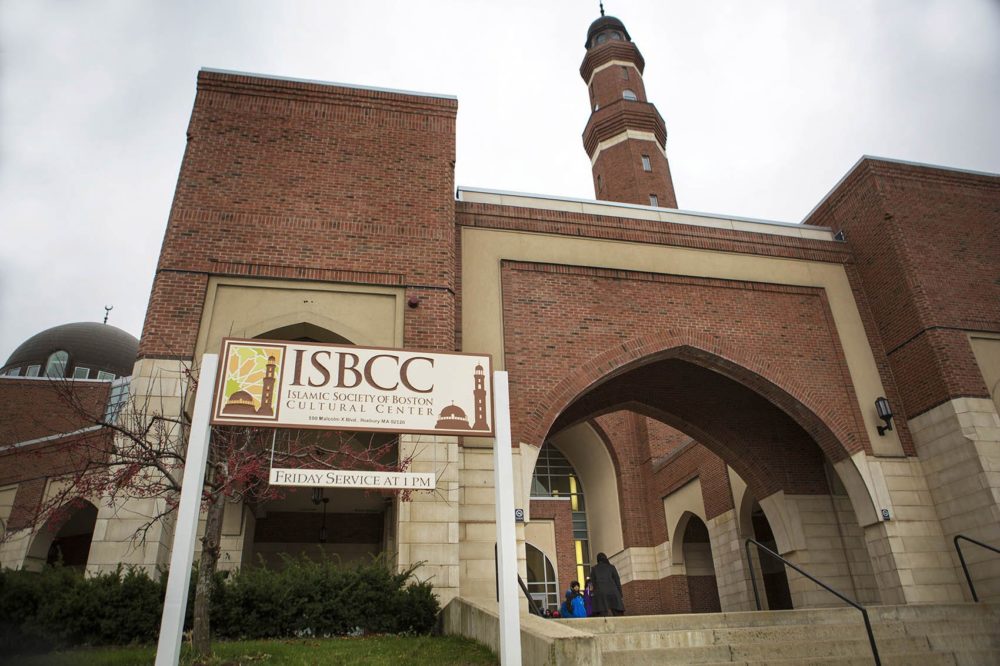Humanizing American Muslims
An excerpt from the book Fear in Our Hearts: What Islamophobia Tells Us about America

(Image source: Shutterstock)
The following excerpt comes from Caelb Iyer Elfenbein’s book Fear In Our Hearts: What Islamophobia Tells Us About America. The book explores reasons for America’s anti-Muslim attitudes and hate crimes, and what everyone can do to make the United States a safer place for Muslims.
This excerpt comes from the books fifth chapter: “Humanizing Public Life.”
***
 In November 2015, Samer Shalaby stood before a packed room in Fredericksburg, Virginia. He was at a public planning meeting, representing the Islamic Center of Fredericksburg, whose members were seeking to build a new mosque to replace one that had served area Muslims for over thirty years. When we enter the scene, things are more or less moving along as you might expect at this kind of meeting. Storm drains. Sewage removal. Traffic. Parking spots. And then things quickly change.
In November 2015, Samer Shalaby stood before a packed room in Fredericksburg, Virginia. He was at a public planning meeting, representing the Islamic Center of Fredericksburg, whose members were seeking to build a new mosque to replace one that had served area Muslims for over thirty years. When we enter the scene, things are more or less moving along as you might expect at this kind of meeting. Storm drains. Sewage removal. Traffic. Parking spots. And then things quickly change.
One member of the audience asks a question about parking spots. Would forty be enough to accommodate all the worshippers?
“That’s forty too many,” one audience member says, first softly and then louder, with more confidence.
There is a murmur in the crowd.
“Let me tell you something,” he continues. “Nobody. Nobody. Nobody wants your evil cult in this town.”
Some people voice obvious displeasure at where this is heading. Other people clap and encourage him to continue, which he does.
“I will do everything in my power to make sure that does not happen.”
Another voice chimes in, “We don’t want it.” Others clap.
“Because you are terrorists. Every one of you are terrorists. I don’t care what you say. I don’t care what you think.”
Samer meets the outburst with a bemused, nonthreatening expression as some others continue to clap.
“You can smile at me. You can say anything you want. Every Muslim is a terrorist. Period.”
Samer begins to speak in a calm manner.
“Shut your mouth. I don’t want to hear your mouth. I’m done with you. Everything that I will do, everything I can do, to keep you from doing what you are doing, will happen. That will happen.”
Law enforcement officers ended the meeting after the audience member walked out.
It’s not necessarily unusual that a planning meeting turns contentious. But this incident is of a different nature than disagreements about stop signs, traffic lights, or run-of-the-mill building permits.
What the audience member said to Samer is, sadly, not all that surprising. What is surprising, though, is that the audience member felt so free to speak publicly in this way. Aside from murmurs of dissent, no one intervened. No one shouted down the audience member.
A planning meeting like this one exemplifies local public life. The fact that the audience member was able to accuse Samer of being a terrorist without any apparent repercussions—in fact, with open support from some other audience members—reflects the conditions of public life in our country. It’s pretty easy to imagine how such an encounter in public space could leave someone with questions about whether they are full citizens.
The familiarity on display in the meeting is striking. People refer to each other by first name. The proposal under discussion is clearly part of an ongoing discussion. After all, the Islamic Center of Fredericksburg has been around for over three decades with no incident. The Shalaby family has been a part of the community for almost as long and, as a trustee of the Center, I am sure Samer has been in front of that same room many times before. The whole incident just doesn’t add up.
There is a disjuncture between the familiarity that comes from shared histories and experiences in local communities and the kind of hostility on display in this meeting. It seems that for the hostile audience member and those who encouraged him Samer was just a stand-in for a larger, more abstract group. “Every one of you are terrorists.”
***
On Monday, February 26, 2017, Mohammad Qamar stepped up to the podium at a meeting of the Downtown Rotary Club in Sioux Falls, South Dakota. He’d been invited to address the civic organization as the director of his mosque’s public outreach and interfaith initiatives.
After introducing himself—and noting that he has two kids, both of whom were born in the United States—he says, “I have a confession to make. I’ve been doing talks such as this, visiting churches over the past year, hosting different groups at our center. But I would much rather not have to do this.” And yet he’s there, which he says “is not just important. It is a necessity.”
Dr. Qamar, a nephrologist, arrived in the United States in 2004. He is a member of South Dakota Faith and Public Life, which describes itself as a group of religious leaders committed to respectful discussion of difficult social and political issues. His deep engagement with public life is clear. Now here he finds himself giving a talk that I’m sure he has delivered many times over. He spends a lot of time describing why.
Sometimes he uses humor to do so, noting, for example, that while approval ratings of Muslims are going up, they still are competing with pretty much only zombies at the low end of the scale. Most of the time, though, he is serious. He notes that the number of anti-Muslim hate groups increased from four in 2010 to over one hundred in 2016. He discusses the fact that nearly six in ten Americans report not knowing anyone who is Muslim.
He has taken on the burden of speaking to audiences in Sioux Falls so that in his city, at least, that figure will decrease. He is humanizing himself so that Muslims don’t remain an undifferentiated other. He wants his audience to feel like they know him and that he fundamentally shares their values.
He talks about his first visit to the United States, which happened to coincide with the September 11 attacks, to illustrate this point. He talks about being terrified, of wanting to return to Pakistan as soon as he could. But what he found surprised him. He describes feeling like President Bush was speaking directly to him when he offered reassuring words that Islam was a religion of peace. Although he was aware of anti-Muslim activity occurring across the country in the wake of the attacks, he describes experiencing tremendous kindness from those around him.
He decided then and there that he wanted to make the United States his home.
***
It’s hard to move past the idea that Dr. Qamar thinks outreach of the kind he does “is not just important. It is a necessity.”
During his talk, he says that he and the other three thousand or so Muslims in Sioux Falls have decided to make the small city their home because they feel comfortable. They feel certain that, despite the conditions of public life nationally, they and their kids can move through their everyday lives in Sioux Falls without serious, immediate threat.
Yet his mosque has an entire center devoted to public outreach, which, despite having a demanding professional life and kids at home, he directs. He also clearly spends a lot of time preparing and giving talks to audiences like Rotary. Why?
Together, the stories about Samer Shalaby and Mohammad Qamar present in microcosm a larger phenomenon in American public life. The anti-Muslim sentiment on display during Samer Shalaby’s town planning meeting presentation exemplifies the conditions of public life that have emerged with a general rehabilitation of public hate. Mohammad Qamar’s talk at the Rotary club helps turn our attention to how American Muslims have responded to these conditions in showing how and why they are part of this country.
Read side by side, these stories highlight the fact that both anti-Muslim sentiment and American Muslim participation in public life aren’t always simply reflections of direct experiences that people have. We draw on things we see on TV, read on social media or in magazines or books, and hear from friends near and far. These indirect experiences also inform the paths we take in our public lives.
It’s unlikely that many people clapping in the audience at the 2015 planning meeting in Fredericksburg had direct experience supporting the claim that every Muslim is a terrorist. Still, their clapping and encouragement suggested that they had traveled far down a certain path guiding their participation in public life in that moment. This path was cleared by people seeking to rehabilitate public hate, taking a fact—that there are a small number of Muslims in the world who do awful things—and distorting it into terrible generalizations about millions of people.
For his part, Dr. Qamar stood before the Downtown Rotary Club in Sioux Falls because others around the country had been so successful in paving this path of public hate, not because of a particular history of anti-Muslim activity in the city. In response, he was following, and helping to further build, another path of public life, one built on the idea that humanization—the simple idea of reminding others of our common humanity—makes it harder to hate.
The paths we select as we decide how, when, where, and why to engage in public life typically reflect our local settings. Yet these settings, and thus our decisions related to public life, are always tied into larger networks. Studying anti-Muslim sentiment and activity shows in very real terms that the conditions of public life come from the complex interaction of local and national factors.
This national-local dynamic explains how something like anti-Muslim sentiment and activity exists in very different places across the country—towns and cities with and without Muslim communities, towns and cities that have and have not experienced violence perpetrated by Muslims. It also explains how American Muslim responses to anti-Muslim sentiment and activity have unfolded across the country.
Reading these stories side by side also highlights the close relationship between anti-Muslim sentiment and the humanizing work of American Muslims. It’s not really possible to understand the remarkable growth of outreach efforts undertaken by everyday American Muslims across the country—like Dr. Qamar in Sioux Falls—without considering the rise of anti-Muslim sentiment and activity like we saw in Fredericksburg.
These hostile conditions in effect create a need—even a requirement—for American Muslims to engage in public life in particular kinds of ways. Their own fear, they own expectations of routine harm, have created the need to minister to others’ fears. This has led to an unprecedented, largely organic, outreach and public engagement effort by American Muslim communities.
Humanizing outreach comes in many different shapes and sizes. The goal, whatever the form, is always the same: humanizing Muslims in the face of anti-Muslim sentiment that assumes that all Muslims are the same (bad, in a nutshell).
An April 2018 mosque open house event in Roxbury, Massachusetts, captures the spirit of this kind of work. The event featured tours of the mosque, mini classes about Islam, opportunities to learn about Arabic calligraphy, and an afternoon prayer that visitors could observe. Above all else, the open house provided opportunities for people of all ages to talk together. Speaking to the Boston Globe, Yusufi Vali, one of the organizers, said of the event, “The real benefit of this is people get to meet real people and make their own judgments about who Muslims are.”

(Mosque in Roxbury, MA. Photo source: Jesse Costa for WBUR)
By embarking on an incredibly ambitious humanization effort in the face of rising anti-Muslim sentiment, Muslim communities and individuals have worked hard to create a path for others to follow when fear descends on public life. Many non-Muslims have certainly supported them in this work, but the resiliency American Muslims have shown in responding to anti-Muslim sentiment and activity is really quite remarkable.
In many of the media reports I’ve read, people doing this humanizing work have expressed joy at the connections their outreach has made possible. Just because they enjoy the work, though, doesn’t mean that the conditions of public life have left them with much choice about doing the work in the first place. Are Americans like Samer Shalaby and Mohammad Qamar really free to choose how they engage in public life? The answer to this question, at least as I’ve come to think about it in researching and writing this book, troubles me.
During the question-and-answer session of Dr. Qamar’s talk, one member of the audience asked him where they could find moderate Muslim voices denouncing extremism. This request is a common variation on the general theme of collective responsibility. In response, Dr. Qamar provided a number of resources and issued an open invitation for everyone to visit his mosque and ask any questions they had about Islam.
I’m not sure the person who asked the question recognized that Dr. Qamar was a living, breathing answer to the question—or perhaps he just thought that Dr. Qamar was an exception.
No matter how misguided it may be, the commonness of the audience member’s question is precisely why Dr. Qamar thinks it’s “not just important,” but “a necessity” to give talks like the one at the Downtown Rotary Club. He and others trying to humanize Muslims to non-Muslim audiences are doing so because of assumptions that all Muslims are responsible for the bad things that other Muslims do.
These assumptions, as well as the conditions of public life for American Muslims in general, in effect demand a response from Muslim communities—an accounting of why all Muslims should not be subject to suspicion.
There are Muslims, or people identifying as Muslim, who do terrible things. The same is also true for virtually every other conceivable group of people. Yet there is a particular demand on Muslims for a collective response, and it comes in different forms. The question posed to Dr. Qamar is an example of an explicit demand for a response. The planning meeting in Fredericksburg is an example of an implicit, but no less pressing, kind of demand.
For a community made insecure by anti-Muslim sentiment and activity around the country, demands by others require a response. For the thousands and thousands of people engaging in these efforts over many years, the requirement for humanizing work has meant less time with family, less time building careers, and less time participating in public life in other ways. In very important respects this was not truly a form of voluntary participation in public life, which is a crucial element of life in a democratic system.
In the face of horrifying levels of public hate, American Muslims like Dr. Qamar and so many others have nonetheless responded to these demands as they try to humanize the conditions of Muslim public life. As they have gone about this very difficult—even if sometimes joyful—task, American Muslims have provided a model of public life that looks at fear head on and chooses a different path, a path of openness and welcome.
American Muslims serve as an example to others because so many of their relatively small number in the United States have done, and continue to do, such an amazing job meeting fear head on with openness and transparency. Yet this is a burden that no vulnerable community ought to bear. The burden to humanize oneself and others with whom we might share elements of our identities because of other people’s fears cuts against a core principle of our democracy: that all of us have the right to decide when, where, how, and why to participate in public life.
Caleb Eyer Elfenbein is Associate Professor in the Departments of History and Religious Studies at Grinnell College where he is also Director of the Center for the Humanities.
***
Interested in more on this topic? Check out episode 20 of the Revealer podcast: Combating Islamophobia in America.